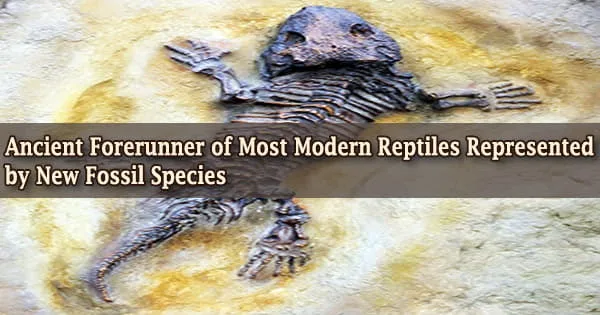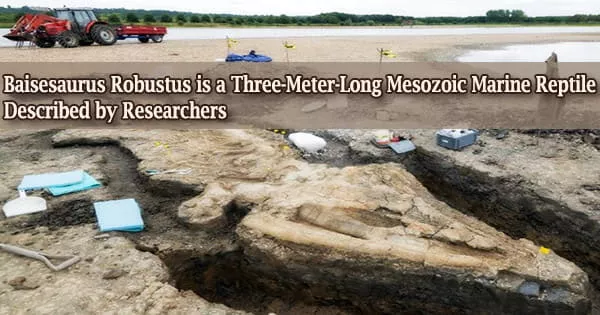Lizards and snakes play an important role in today’s terrestrial ecosystems. Squamates (all lizards and snakes), along with the colorful tuatara of New Zealand (a “living fossil” represented by a single living species), make up the Lepidosauria, the biggest group of terrestrial vertebrates on the world today, with roughly 11,000 species, and by far the largest contemporary reptile group.
Squamates and tuataras have a lengthy evolutionary history in common. Their lineages predate dinosaurs, having begun and separated some 260 million years ago.
However, the early stage of lepidosaur evolution, which occurred between 260 and 150 million years ago, is marked by fragmented fossils that do not provide much useful information for understanding their early evolution, leaving the origins of this vastly diverse group of animals a mystery for decades.
An international team of researchers describe Taytalura alcoberi, a new species that represents the most primitive member of the lepidosaurs, in a report published on August 25 in Nature. Taytalura alcoberi was discovered in the Late Triassic strata of Argentina.
Taytalura is the earliest three-dimensionally preserved early lepidosaur fossil, discovered by main author Dr. Ricardo N. Martnez, Universidad Nacional de San Juan, Argentina, and curator at the Instituto y Museo de Ciencias Naturales.
It allowed scientists to extrapolate its position in the reptile evolutionary tree with high confidence, bridging the gap in our understanding of the origin and early evolution of lepidosaurs.
Martnez and co-author Dr. Sebastián Apestegua of Universidad Maimónides in Buenos Aires, Argentina, used high-resolution CT scans of Taytalura to confirm that it was a lizard-like creature.
It’s not even a lizard in the evolutionary tree; but it’s the very next thing there, between true lizards and tuataras, and all other reptiles.
Simões
They then enlisted the expertise of co-author Dr. Tiago R. Simes, a postdoctoral scholar in Harvard University’s Department of Organismic and Evolutionary Biology, to identify and analyze the fossil.
Simes is an expert on these creatures, having published the largest dataset on the evolution of the major groups of reptiles (both alive and extinct) in Nature in 2018.
“I knew the age and locality of the fossil and could tell by examining some of its external features that it was closely related to lizards, but it looked more primitive than a true lizard and that is something quite special,” said Simões.
To process the CT scan data, the researchers contacted co-author Dr. Gabriela Sobral, Department of Palaeontology, Staatliches Museum für Naturkunde Stuttgart, Germany. Sobral, a CT data expert, developed a mosaic of colors for each bone in the skull, allowing the scientists to see the anatomy of the fossil in high detail on a scale of only a few micrometers, about the same thickness as a human hair.
Simões was able to determine the right placement of the fossil in the reptile dataset using Sobral’s data and a Bayesian evolutionary study. Simes had recently used the Bayesian approach to precisely estimate the duration and rates of anatomical development during the rise of tetrapods, which was modified from methods originally developed in epidemiology to examine how viruses like COVID-19 evolve.
Taytalura was the most primitive member of the lineage that eventually gave rise to all lizards and snakes, according to the statistical analysis.
“It’s not even a lizard in the evolutionary tree,” said Simões, “but it’s the very next thing there, between true lizards and tuataras, and all other reptiles.”
“This beautifully 3D preserved fossil is really an important finding. It is the most complete fossil representing the early stages of lepidosaur evolution that we have so far. All other known fossils are too incomplete, which makes it difficult to classify them for sure, but the complete and articulated nature of Taytalura makes its relationships much more certain,” said Sobral.
Simões agreed, “Taytalura is a major point in the reptile tree of life that was previously missing. Because these fossils are so small they are very difficult to preserve in the fossil record. And what candidate fossils we do have are very fragmented and poorly preserved, so they don’t provide as much useful data for analysis.”
Taytalura’s skull demonstrates that the early lepidosaurs resembled tuataras far more than squamates, implying that squamates represent a significant departure from this ancestral pattern. It also features a distinct dentition, which is unlike that of any other extant or extinct lepidosaur.
“What our analyses tells us, besides some other anatomical traits that we could see on it, in the skull specifically, is that this sphenodontian body type, at least for the skull, is the ancestral pattern for lepidosaurs. The ancestral pattern seems to be more similar to tuataras,” said Simões.
“Taytalura preserves a composition of features that we were not expecting to find in such an early fossil. For instance, it shows some features that we thought were exclusive for the tuatara group. On the other hand, it made us question how truly “primitive” certain lizard features are, and it will make scientists reconsider several points in the evolution of this group,” said Sobral.
“The almost perfectly preserved Taytalura skull shows us details of how a very successful group of animals, including more than 10,000 species of snakes, lizards, and tuataras, originated,” said Martínez.
“But it also highlights the paleontological importance of the paleontological site of Ischigualasto Formation, known for preserving some of the most primitive dinosaurs known in the world. The extraordinary quality of preservation of the fossils at this site allowed something as fragile and tiny as this specimen to be preserved for 231 million years.”
“Contrary to almost all fossils of Triassic lepidosaurs found in Europe, this is the first early lepidosaur found in South America, suggesting lepidosaurs were able to migrate across vastly distant geographic regions early in their evolutionary history,” agreed Simões.
“We are accustomed to accept that the Mesozoic Era was an age of gigantic reptiles, enormous proto-mammals, and huge trees, and thus we commonly look for fossils that are visible at human height, just walking,” said Apesteguía.
“However, the largest part of the ancient ecosystem components was small, as today. There was a universe of fauna sneaking among bigger, clawed, or hoofy paws. Taytalura teaches us that we were missing important information by looking not only for bigger animals but for also thinking that the origin of lizards occurred only in the Northern Hemisphere as evidence seemed to support until now.”
Taytalura is a primitive lepidosaur, however, it is not the oldest. The fossil is 231 million years old, however, there are also real lizard fossils dating back 11 million years.
The team expects to identify comparable or different species from the same lineage that branch right before the genesis of genuine lizards by exploring older sites.
















